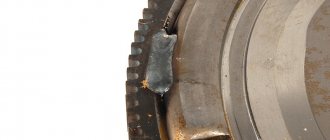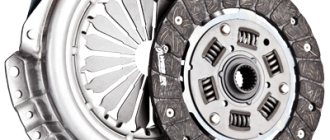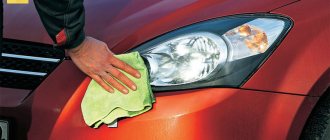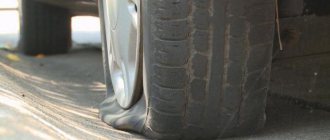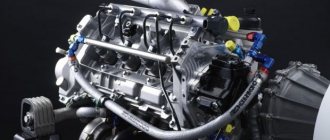A running internal combustion engine produces a very uneven torque on the shaft. Even when choosing such “classic” well-balanced designs as V 6, V 8 and V 12, the angular speed of the crankshaft is far from constant. In addition to the uneven working strokes of the engine, this is also affected by fluctuations from the drive load - the timing mechanism, various auxiliary units and other components. The flywheel, which by the early 2000s had a complex but effective design, allows for minimizing vibrations and ensuring the most comfortable ride possible. Read about how dual-mass flywheels are designed and what their advantages and disadvantages are in our material.
The load on the engine is also not constant; it has pronounced peaks of arbitrary frequency and amplitude. All these factors generate torsional vibrations of the crankshaft and vehicle transmission elements. Moreover, the magnitude of torsional vibrations can exceed the magnitude of the engine torque by several times and even orders of magnitude. This means that the crankshaft and many transmission elements must be made with a good margin of safety. They try to combat torsional vibrations with the help of dampers, and flywheels are used to change the natural frequency of vibrations and prevent resonance.
The “classic” solution in the form of a rigid flywheel and a torsional vibration damper on the clutch disc has coped with its tasks for almost half a century. A fairly simple and cheap design failed only with a simultaneous increase in requirements for the quality of operation of the clutch mechanism, a decrease in idle speed, the speed of reaching the load after start, and an increase in the transmitted torque.
Under such conditions, the resonance frequencies of the structure came dangerously close to the natural vibration frequencies of the already extremely lightweight crankshafts of modern engines. And the load on the transmission was growing. Increasing the flywheel mass as the load increases is economically ineffective: dynamics will decrease and fuel consumption will increase. In addition, the maximum amplitude of torsional vibrations increases during impacts in the transmission, which is also not good. But it is possible to increase the efficiency of the damper, but for this it is necessary to significantly increase the dimensions and complicate the device.
A solution has been found. The damper was moved from the clutch driven disc to the flywheel. And the flywheel itself of this design is called dual-mass. Because it consists of two massive parts connected to each other through a spring-hydraulic torsional vibration damper.
The auto industry owes much of the massive use of dual-mass flywheels to the “diesel invasion” and the growth in power. A diesel engine has a much higher torque swing depending on the crankshaft angle. A typical 4-cylinder diesel engine develops 300 Nm of torque at idle and about 700 Nm at low operating speeds; The 6-cylinder engine idles a little smoother, and the amplitude is “only” 280 Nm.
But gasoline engines at idle are much more balanced: the amplitude is about 35 Nm for in-line engines. And at low speeds under load, the amplitude of torque fluctuations is noticeably lower - about 300 Nm. The dual-mass flywheel completely isolates the transmission from torsional vibrations from the engine at any speed and allows you to increase the transmitted torque by an average of 10%! for diesel engines and by 5%! for gasoline engines, make driving at low speeds more comfortable, and reduce the load on the engine mount and the transmission as a whole, to avoid engine overloads during impacts from the transmission, to make working with the clutch on powerful engines more comfortable.
Specialists from Trialli, a Russian manufacturer of transmission components, said that the introduction of dual-mass flywheels certainly solved the problem of resonant oscillations, but gave rise to a new one - a short product life. Due to their design features, dual-mass flywheels usually cannot withstand more than 80,000 km and require expensive replacement - on average about 30,000 rubles. “For a robotic gearbox, this is inevitable: the clutch basket petals must always be in the same position when the actuator is operating. To achieve this, wear compensation technology was introduced into the clutch pressure plate to level out wear on the friction elements of the driven disc and wear on the basket pressure plate. But for a manual transmission, the effectiveness of dual-mass flywheels is not so clear. The driver will not feel a fundamental difference in movement, and therefore there is an opportunity to save on transmission repairs by converting a dual-mass flywheel into a conventional single-mass flywheel and, accordingly, installing a kit for a single-mass flywheel during subsequent repairs,” stated Trialli Marketing Director Kirill Shipota.
By 1997, most engines larger than 2.0 liters were equipped with dual-mass flywheels. And only in engines with a volume of less than 1.6 liters were they practically not used. At the moment, the percentage of technology penetration has become higher, almost all new cars with gasoline engines with a volume of about two liters and almost all diesel engines are equipped with them.
We recommend: Manual Transmission Malfunctions
The first dual-mass flywheels on production cars appeared in 1985 on BMW diesel engines. The design of the first flywheels produced by LuK was quite complex. The two masses were connected by a planetary gear, and the centers were connected through a large diameter ball bearing. The damper springs were placed separately, had one level of elasticity and operated in viscous oil.
Further progress in designs followed the path of reducing size and cost. Already the third generation of dual-mass flywheels has lost the centering planetary gears, limiting itself to just one central bearing. Later attempts were made to remove the expensive rolling bearing, replacing it with a bushing, or to reduce the diameter of the bearing as much as possible. The springs received progressive characteristics, mainly due to the use of the second and third springs, which were shorter, and the filtration amplitude increased.
Later, a limiting moment was introduced - a friction clutch to prevent increased loads on the transmission. In 2010, BMW with the N47 diesel engine used a design with a rotating pendulum, which reduces torque vibrations at low speeds.
The use of dual-mass flywheels is not limited to manual gearboxes and robotic transmissions. The 1999 Audi Multitronics CVT was the first design of its kind with a dual-mass flywheel. In 2008, a dual-mass flywheel was used for the first time with an automatic transmission with a gas turbine engine on Audi A6 models with diesel engines. The scope of application of dual-mass flywheels is gradually expanding, primarily due to an increase in engine torque at low speeds and a decrease in the number of cylinders, and therefore an increase in the amplitude of engine torque vibrations.
In addition to the standard design of the dual-mass flywheel, various modifications of the part, created for even higher loads, have become widespread. One of the manufacturers of such modernized elements is Valeo, which has offered two types of dual-mass flywheels.
Dual-mass flywheel with internal damper This technology dampens vibrations even at the highest speed ranges. In addition to the two curved springs, small springs - less sensitive to centrifugal load - are built into the clutch disc. This technology is suitable for demanding applications such as rear wheel drive vehicles where very low vibrations at the transmission input level are required.
Long Stroke Damper (LTD) This technology, in addition to curved springs, features two rows of three springs that operate in series and are synchronized by the backplate. Two straight springs are less sensitive to centrifugal force and provide less friction than curved springs. This combination allows for optimal filtration due to maximum angular displacement. This highly efficient technology provides outstanding driving comfort and all the qualities required for powerful engines as well as a hybrid powertrain.
Dual-mass flywheels turned out to be a rather complex design. Unlike single-mass, which essentially consists of two parts - the disk itself and the ring gear, here the number of parts increases to 30–50. And some of them move relative to each other. The number of possible malfunctions also increases. In addition to overheating and wear of the contact plate, breakage of the ring gear, wear and breakage of springs, lubricant leaks, breakage of bearings, destruction of parts of the centering apparatus and violation of the relative position of parts have now been added to the number of malfunctions. Even in the absence of wear on the contact surface, by 150–200 thousand km the flywheel will require repair or replacement due to other breakdowns.
Diagnosis of breakdowns of this element is complicated by the fact that over a mileage of more than a hundred thousand kilometers, the source of increased levels of vibration and noise can be wear and tear of the engine power supply and control system, damage to its suspension and transmission breakdown. And the wear of the dual-mass flywheel increases the wear of all related elements, engine, transmission and other parts. For a more thorough diagnosis, it is recommended to perform an instrumental check of the radial and axial play of the flywheel masses, check the modulus of elasticity of the springs and visually inspect the structure for damage, oil leaks, loss of balancing weights, wear of the contact plate and other damage.
Who is he and where is the flywheel located?
The classic flywheel itself is quite simple - it is a massive metal disk with a diameter of about 30-40 centimeters. It is usually made from cast iron.
We recommend: Central locking in a car - what is it, how it works, video
Along the outer circumference of this circle is a steel rim with teeth, called the flywheel crown. Gears play a very important role in this unit, but we will talk about this a little later.
Where is the flywheel located? You won't be able to find the flywheel under the hood of a car at first glance. This part is located deep in the engine and is protected from prying eyes by casings.
More precisely, the place of this metal disk is at one of the ends of the crankshaft, which, as you already know, is spun by the engine pistons.
The flywheel is attached to the crankshaft very firmly, since it has to withstand extreme loads and act as an intermediary between the engine and the gearbox.
We have already talked about what the flywheel looks like and where its place in the car is, now we need to find out the most important thing - whether it is really needed. Despite the external simplicity and the absence of complex shapes, without this part the car will not start moving, and indeed will not start at all. The flywheel performs the following functions:
- damping of parasitic crankshaft vibrations;
- transmission of engine torque to the transmission;
- ensuring connection between the starter and the crankshaft.
Let's take a closer look at the above points. One of the key roles of the flywheel is to guarantee smooth operation of the engine and dampen various types of mechanical vibrations and vibrations.
It is for this purpose that the disk is made of heavy cast iron - the main thing here is its mass, which ensures the accumulation of energy and maintenance of the crankshaft torque using inertia.
The next role is no less important - the flywheel acts as an intermediary between the engine and the gearbox, and is also, in fact, part of the clutch mechanism. All the engine power and torque, which car enthusiasts love to brag about, passes through this modest but heavy disk and rushes further through the transmission to the wheels.
And finally, the last function of the flywheel. A little earlier, when describing the structure of this part, we mentioned the teeth located along the outer circumference of the disk, the so-called crown.
With their help, the moment you turn the key in the ignition switch, the starter gear engages with the above-mentioned teeth, which creates primary rotation of the crankshaft and starts the process of fuel combustion in the cylinders. In other words, the engine starts working.
How to deal with engine vibration
The power and speed of cars are growing in proportion to the public's needs for comfort. And increasing engine power is associated with a lot of problems that do not always coexist peacefully with comfort and other requirements for modern technology. This includes increased fuel consumption, uneven engine operation, increased noise and vibration. If for a sports car all these conventions can be written off, then a comfortable business-class car must fully meet the requirements for comfort.
Vibrations have always bothered designers and there is no escape from vibrations. It is possible to calm a vibrating part or shaft only by creating an anti-load, a counterweight. And this, naturally, increases the mass of the mechanism. For example, you can look at wheel balancing at a tire shop. If you do not hang a load of a certain weight on the wheel in a certain place, vibration cannot be avoided. But we will increase the sprung mass, which is harmful to the condition of the chassis. Almost the same story is observed with the crankshaft of a car. To avoid unnecessary vibrations, a special balancer or flywheel is used.
Description
The flywheel is made in the form of a wheel with a diameter of up to 40 cm. Thanks to it, the kinetic energy of engine rotation occurs, which ensures smooth rotation of the crankshaft when the pistons pass dead spots. The flywheel can be conditionally classified as different systems of the power unit, since it takes part in the operation of each of them:
- As part of the crank mechanism due to participation in the torque of the crankshaft and reduction of the unevenness of its movement.
- As part of the transmission by performing the function of the clutch drive disc.
- As part of a gearbox in the form of a driven gear when transmitting torque from the starter to the crankshaft.
What does the device consist of?
This is not a simple “piece of iron”; the structure here is much more complex. The structure of flywheels with two masses is different. As it becomes clear, here there are, as it were, two disks that are combined into one device (two masses). Each of the masses is attached to its source - one to the engine, the other to the gearbox. Moreover, these two disks can rotate freely from each other; they are connected only by a bearing
However, this way we won’t “move” the car; we need the torque to be transmitted from the power unit to the box and then to the wheels. That is, these two masses need to be somehow connected to each other. THIS is what the internal parts of the structure do, namely springs, flanges (they come in many types - asterisk, polygon, gear). The whole thing is closed with an airtight sealing cap. It is worth noting that the springs and internal cavity are often filled with lubricant
Let's look at a small diagram
This is one of the most common types, there are others, but they all have the same principle
Types of flywheels
Currently, there are three types of flywheels:
Solid
The most common and simple design. It is a cast iron disk, the structure of which was described above. The flywheel for an automatic transmission is much lighter than a conventional one, since it is designed for use in conjunction with a torque converter.
Lightweight
When tuning a car, transmission and engine, a lightweight flywheel is often installed. Its light weight reduces inertia and increases engine performance by 4-5%! The car responds faster to the gas pedal and becomes more dynamic. However, installing a lightweight flywheel should only be done in conjunction with other work to improve engine and transmission performance.
Using lightweight flywheels without modifying the piston and timing gear will lead to unstable engine operation at idle speed.
Dual mass
The dual-mass or damper flywheel is more complex in design and is installed on modern car models. It can be used on vehicles with manual and automatic transmissions without a torque converter. In the case of a manual transmission, a clutch disc without a torsional vibration damper is used.
We recommend: How to make a heated windshield with your own hands
Not all flywheels are the same
The development of technology and the progress of engineering have not bypassed the classic flywheel.
Designers, in an attempt to find effective methods for damping parasitic engine vibrations, created a more complex interpretation of this unit, which began to appear under the hoods of production cars in the late 80s of the twentieth century.
So, today you can find the following varieties of this element:
- solid (the classic disc most widely used in the automotive industry; this is what we have been talking about throughout our story);
- dual-mass (damper);
- lightweight.
Solid flywheel
We have already talked about the first, most common design, so let’s move straight to the second – the most interesting from an engineering point of view.
Dual mass flywheel
A dual-mass flywheel is, roughly speaking, two metal disks connected to each other by a special spring system.
The designers resorted to this trick in order to protect the transmission from sudden overloads, get rid of vibrations of the crankshaft and engine as much as possible, increase convenience when changing gears and other amenities.
But, as always, there is a flip side to the coin - the dual-mass circuit itself is subject to increased wear, and especially its spring system.
Lightweight flywheel
Lightweight flywheel options naturally reduce mechanical losses, and the engine reaches maximum speed faster. Less energy is spent for spinning, which gives a small fuel saving, about 2 - 3%!, no more.
With these advantages, the strength of the flywheel is still lost. It requires additional balancing, in conjunction with the crankshaft and front pulley. Also, the cost of factory lightweight flywheels is higher.
Well, our dear readers, another story about the parts and components that form the basis of our cars has come to an end.
Stay tuned for further publications.
Tags
engine
Flywheel design
The flywheel is cast from gray cast iron, which makes its production not too expensive. A crown is pressed onto its outer edge, which is a steel rim with a uniform pitch of teeth, which transmits the rotation of the starter when starting the engine. The design itself is designed in such a way that the middle of the part is made lightweight, and the main mass is placed near the outer edge to increase inertia. The product has 6 holes for mounting to the crankshaft using a flange and other holes for attaching the clutch basket.
Dual-mass flywheel repair
Faulty dual mass flywheel
Due to the high cost of original spare parts, many drivers are thinking about the possibility of repairing the flywheel. It is worth saying right away that manufacturers do not imply repair of this part. It is not removable and it is better to install a new one.
But there are still craftsmen who get to work. It all depends on the level of damage. If the springs fail, the service can replace them. They are the first to wear out. But if the housing or one of the bearings is damaged, then it is better to purchase a new one. In any case, few people will guarantee stable operation of the engine and transmission after repair.
Replacement with single-mass
Theoretically, it can be replaced. A good service technician will do this without any problems. But is it worth it? No one can predict how long the gearbox and engine will last after this, so for our part we do not recommend it!
If you have a powerful engine and a manual transmission, then you cannot avoid strong vibrations and shaking when starting and stopping. It will be possible to drive, but with great discomfort. The robotic gearbox will not withstand a tandem with a solid flywheel and will quickly fail. And together with the box, the repair will cost much more.
Malfunctions and breakdowns
The service life is now approximately 150 - 200,000 km. After this, the first signs of failure of this unit begin to appear:
- Creaking sound when starting or stopping the engine. It sounds like the starter is still spinning.
- Strong vibrations that have not been encountered before (for example, at idle) many confuse them with “triple” of the engine. Moreover, after the speed increases, the vibrations go away. The thing is that such flywheels operate on a two-stage principle; at idle speed some elements (the so-called soft ones) work, and at high speeds others (hard ones). This is why vibrations can occur at different speeds.
- Clicking noise when starting or accelerating
If you experience at least one of the listed points, then most likely it is either failing or has already failed.
What problems does this element have and can you identify them yourself?
Defects are mainly associated with the leakage of special lubricant, the appearance of scratches, dents or even creases and cracks on the surfaces. A mechanic at a service station will be able to diagnose all this without removing it from the car, for example, when replacing a clutch disc.
If there are no visible signs of malfunction (but sounds and vibration remain), the damper mechanism, springs may be broken, there are burrs inside, etc. It needs to be removed and diagnosed.
